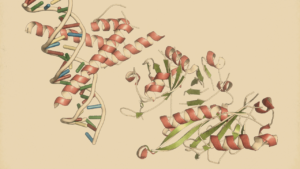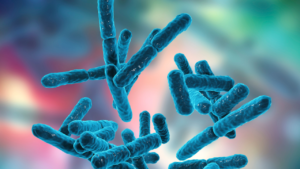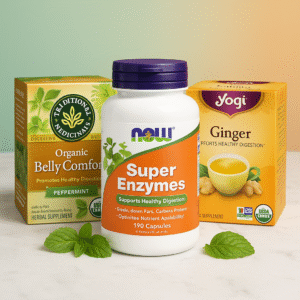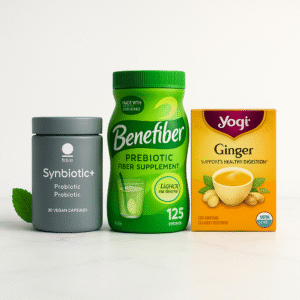10 Plant Extracts, Gut Microbiota, and Obesity Amazing Secrets
Unlock the amazing secrets of plant extracts and their impact on gut microbiota in managing obesity. Discover natural ways to improve your health
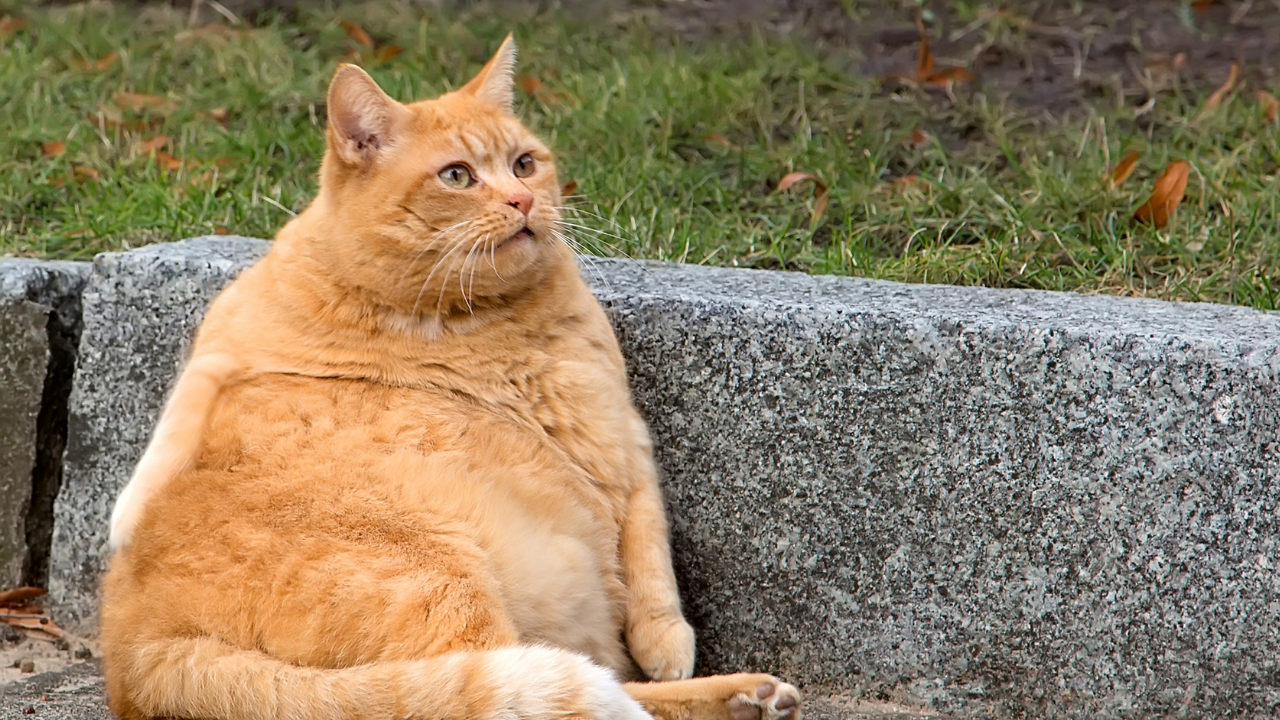
In This Article:
Key Points
- Grape seed proanthocyanidin extract (GSPE) derived from grape seeds shows promise in mitigating obesity and improving various health conditions.
- GSPE can regulate lipid metabolism, reduce serum triglyceride levels, decrease adipose tissue mass, and alleviate inflammation.
- The interaction between GSPE and gut microbiota plays a crucial role in its anti-obesity effects.
- Honokiol (HON), derived from Magnolia officinalis, has therapeutic potential in treating chronic diseases and has been found to reduce body weight and adipose tissue mass.
- HON modulates adipogenesis and lipolysis, improves insulin sensitivity, and targets protein tyrosine phosphatase 1B (PTP1B).
- HON's bioavailability is low, and its metabolization by gut microbiota contributes to its lipid metabolic benefits.
- Capsaicin (CAP) derived from red chili peppers has shown beneficial impacts on obesity by decreasing fat accumulation, converting white adipose tissue (WAT) to brown, and reducing inflammation responses.
- CAP supplementation can boost thermogenesis, enhance brown adipose tissue (BAT) activity, promote WAT browning, and improve glucose homeostasis.
- Konjac glucomannan (KGM) from the konjac tuber has demonstrated potential in managing lipid dysmetabolism and displaying hypoglycemic effects.
- KGM improves lipid metabolism, decreases body weight, alleviates hyperglycemia and inflammatory responses, and interacts with gut microbiota to optimize bowel movement and modulate gut health.
- Chlorophyll, the green pigment found in plants, has potential roles in combating obesity, but further research is needed to fully understand its mechanisms.
Power of Plant Extracts: Your Key to Tackling Obesity
Obesity, a major health threat, is linked to gut microbiota disorders.
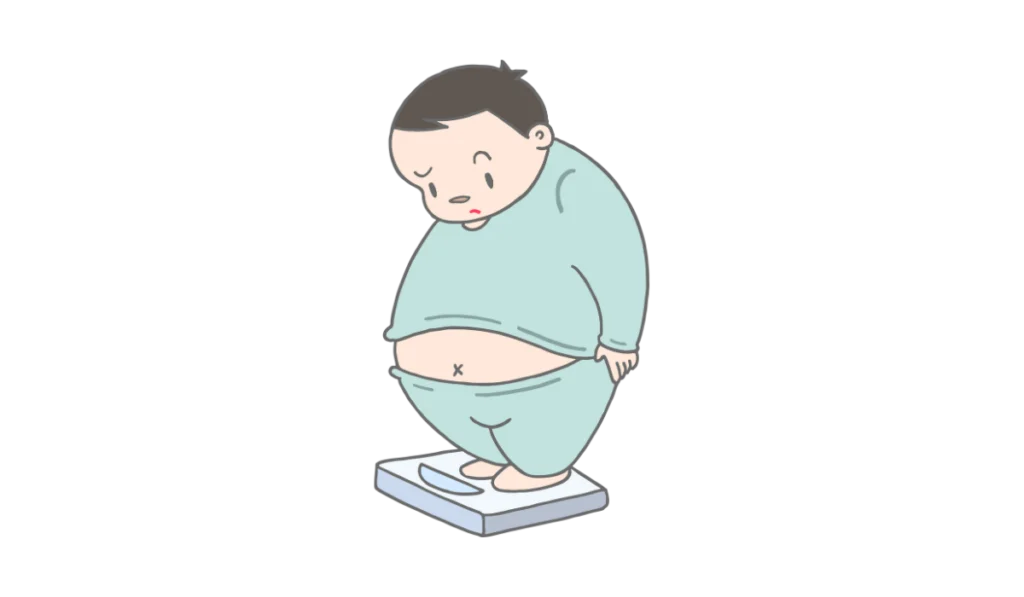
Studies reveal plant extracts, like mulberry leaf, policosanol, and green tea, can combat obesity by improving gut microbiota.
This article explores how these extracts, including honokiol and capsaicin, could be the breakthrough in preventing and treating obesity and its associated metabolic woes, with gut microbiota playing a crucial role.
Plant Extracts, Gut Microbiota, and the Fight Against Obesity
Obesity is a global health crisis affecting people worldwide, and it's marked by a series of metabolic disorders, especially lipid dysmetabolism and its complications, such as diabetes A Trusted Source Wang HN, Xiang JZ, Qi Z, Du M. Plant extracts in prevention of obesity.Crit Rev Food Sci Nutr.(2020) 15:1–14. doi: 10.1080/10408398.2020.1852171PubMed AbstractCrossRef Full TextGoogle Scholar A Trusted Source Duan J, Liang S, Feng L, Yu Y, Sun Z. Silica nanoparticles trigger hepatic lipid-metabolism disorder in vivo and in vitro.Int J Nanomedicine.(2018) 13:7303–18. doi: 10.2147/IJN.S185348 PubMed AbstractCrossRef Full TextGoogle Scholar.
Lipid metabolism, which involves the synthesis and degradation of lipids like triglycerides and cholesterol, is crucial to preventing obesity when properly regulated A Trusted Source Schoeler M, Caesar R. Dietary lipids, gut microbiota, and lipid metabolism.Rev Endocr Metab Disord.(2019) 20:461–72. doi: 10.1007/s11154-019-09512-0 PubMed AbstractCrossRef Full TextGoogle Scholar.
Several factors influence obesity, including genetics, dietary habits, underlying diseases, and physical activity levels A Trusted Source Noland RC. Exercise and regulation of lipid metabolism.Prog Mol Biol Transl Sci.(2015) 135:39–74. doi: 10.1016/bs.pmbts.2015.06.017 PubMed AbstractCrossRef Full TextGoogle Scholar.
Recent studies have pointed out a significant link between obesity and gut microbiota, demonstrating that alterations in gut microbiota can lead to obesity and its associated metabolic diseases A Trusted Source Schwiertz A, Taras D, Schafer K, Beijer S, Bos NA, Donus C, et al. Microbiota and SCFA in lean and overweight healthy subjects.Obesity (Silver Spring).(2010) 18:190–5. doi: 10.1038/oby.2009.167 PubMed AbstractCrossRef Full TextGoogle Scholar.
Gut microbiota dysregulation can increase intestinal permeability and elevate harmful microbial metabolites production, thereby aggravating lipid dysmetabolism, obesity, and related diseases, such as diabetes and non-alcoholic fatty liver disease (NAFLD) A Trusted Source Chen J, Vitetta L. Gut microbiota metabolites in NAFLD pathogenesis and therapeutic implications.Int J Mol Sci.(2020) 21:5214. doi: 10.3390/ijms21155214 PubMed AbstractCrossRef Full TextGoogle Scholar A Trusted Source Hu H, Lin A, Kong M, Yao X, Yin M, Xia H, et al. Intestinal microbiome and NAFLD: molecular insights and therapeutic perspectives.J Gastroenterol.(2020) 55:142–58. doi: 10.1007/s00535-019-01649-8 PubMed AbstractCrossRef Full TextGoogle Scholar.
This makes gut microbiota a potential therapeutic target for obesity management.
Over the years, evidence has shown that diets and nutrients play a role in regulating gut microbiota composition and obesity A Trusted Source Duan Y, Zhong Y, Xiao H, Zheng C, Song B, Wang W, et al. Gut microbiota mediates the protective effects of dietary beta-hydroxy-beta-methylbutyrate (HMB) against obesity induced by high-fat diets.FASEB J.(2019) 33:10019–33. doi: 10.1096/fj.201900665RR PubMed AbstractCrossRef Full TextGoogle Scholar
This review aims to shed light on the anti-obesity activity of plant extracts and their potential mechanisms related to gut microbiota.
Plant Extracts in Obesity: Potential Implication of the Gut Microbiota
The Power of Mulberry: A Natural Solution for Obesity and Gut Health
Mulberry leaf extracts, a traditional Chinese medicine, are rich in flavonoids that have been proven to possess multiple health benefits, including antioxidant, muscle function improvement, cardioprotective, and anti-cancer properties A Trusted Source Shu Y-H, Yuan H-H, Xu M-T, Hong Y-T, Gao C-C, Wu Z-P, et al. A novel Diels-Alder adduct of mulberry leaves exerts anticancer effect through autophagy-mediated cell death.Acta Pharmacol Sin.(2020) 42:780–90 doi: 10.1038/s41401-020-0492-5 PubMed AbstractCrossRef Full TextGoogle Scholar.
Interestingly, these extracts also display significant anti-obesity effects.
Research conducted on hyperlipidemic mice showed that mulberry leaf extract treatment reduced levels of serum total triglycerides, total cholesterol, and low-density lipoprotein cholesterol A Trusted Source Chen J, Li X. Hypolipidemic effect of flavonoids from mulberry leaves in triton WR-1339 induced hyperlipidemic mice.Asia Pac J Clin Nutr.(2007) 16(Suppl. 1):290–4. doi: 10.6133/apjcn.2007.16.s1.55 PubMed AbstractCrossRef Full TextGoogle Scholar.
Similar positive effects on blood lipid metabolism were observed in high-fat diet-fed mice, with mulberry leaf extract administration resulting in weight loss, reduced adipose tissue mass, and improved brown adipose tissue function A Trusted Source Zhong Y, Song B, Zheng C, Zhang S, Yan Z, Tang Z, et al. Flavonoids from mulberry leaves alleviate lipid dysmetabolism in high fat diet-fed mice: involvement of gut microbiota.Microorganisms.(2020) 8:860. doi: 10.3390/microorganisms8060860 PubMed AbstractCrossRef Full TextGoogle Scholar.

Moreover, the extracts also demonstrated the ability to decrease lipid peroxidation and accumulation in the liver of rats A Trusted Source Hsu LS, Ho HH, Lin MC, Chyau CC, Peng JS, Wang CJ. Mulberry water extracts (MWEs) ameliorated carbon tetrachloride-induced liver damages in rat.Food Chem Toxicol.(2012) 50:3086–93. doi: 10.1016/j.fct.2012.05.055 PubMed AbstractCrossRef Full TextGoogle Scholar.
The combination of mulberry leaf extracts with mulberry fruit extract was found to have an additive effect in reducing body weight gain, fasting plasma glucose, and insulin levels, while also mitigating inflammation and oxidative stress in obese mice induced by a high-fat diet A Trusted Source Lim HH, Lee SO, Kim SY, Yang SJ, Lim Y. Anti-inflammatory and antiobesity effects of mulberry leaf and fruit extract on high fat diet-induced obesity.Exp Biol Med (Maywood).(2013) 238:1160–9. doi: 10.1177/1535370213498982 PubMed AbstractCrossRef Full TextGoogle Scholar.
Furthermore, in vitro studies showed that mulberry leaf extract treatment could prevent atherosclerosis by inhibiting the proliferation and migration of aortic vascular smooth muscle cells A Trusted Source Chan KC, Yang MY, Lin MC, Lee YJ, Chang WC, Wang CJ. Mulberry leaf extract inhibits the development of atherosclerosis in cholesterol-fed rabbits and in cultured aortic vascular smooth muscle cells.J Agric Food Chem.(2013) 61:2780–8. doi: 10.1021/jf305328d PubMed AbstractCrossRef Full TextGoogle Scholar.
Importantly, the beneficial effects of mulberry leaf extracts might be linked to gut microbiota, as flavonoids are metabolized by gut bacteria and absorbed in the intestine A Trusted Source Murota K, Nakamura Y, Uehara M. Flavonoid metabolism: the interaction of metabolites and gut microbiota.Biosci Biotechnol Biochem.(2018) 82:600–10. doi: 10.1080/09168451.2018.1444467 PubMed AbstractCrossRef Full TextGoogle Scholar.
FML-treated obese mice exhibited a healthier balance of gut microbiota, with an increase in Bacteroidetes and a decrease in Firmicutes A Trusted Source Zhong Y, Song B, Zheng C, Zhang S, Yan Z, Tang Z, et al. Flavonoids from mulberry leaves alleviate lipid dysmetabolism in high fat diet-fed mice: involvement of gut microbiota.Microorganisms.(2020) 8:860. doi: 10.3390/microorganisms8060860 PubMed AbstractCrossRef Full TextGoogle Scholar A Trusted Source Sheng Y, Liu J, Zheng S, Liang F, Luo Y, Huang K, et al. Mulberry leaves ameliorate obesity through enhancing brown adipose tissue activity and modulating gut microbiota.Food Funct.(2019) 10:4771–81. doi: 10.1039/c9fo00883g PubMed AbstractCrossRef Full TextGoogle Scholar
This shift led to higher levels of acetic acid production, promoting lipolysis and inhibiting lipid accumulation via activation of G protein-coupled receptor 43 (GPR43), a short-chain fatty acid receptor A Trusted Source Zhong Y, Song B, Zheng C, Zhang S, Yan Z, Tang Z, et al. Flavonoids from mulberry leaves alleviate lipid dysmetabolism in high fat diet-fed mice: involvement of gut microbiota.Microorganisms.(2020) 8:860. doi: 10.3390/microorganisms8060860 PubMed AbstractCrossRef Full TextGoogle Scholar
Policosanol: Obesity and Cholesterol Management.
Policosanol, derived from plant waxes, has emerged as a multifaceted solution, demonstrating remarkable bioactivities such as anti-nociceptive, anti-inflammatory, anti-cancer, and anti-parkinsonian properties A Trusted Source De Oliveira AM, Conserva LM, De Souza Ferro JN, De Almeida Brito F, Lyra Lemos RP, Barreto E. Antinociceptive and anti-inflammatory effects of octacosanol from the leaves of Sabicea grisea var. grisea in mice.Int J Mol Sci.(2012) 13:1598–611. doi: 10.3390/ijms13021598 PubMed AbstractCrossRef Full TextGoogle Scholar.
Significantly, its role in combating lipid dysmetabolism and obesity is noteworthy A Trusted Source Cho KH, Kim SJ, Yadav D, Kim JY, Kim JR. Consumption of cuban policosanol improves blood pressure and lipid profile via enhancement of HDL functionality in healthy women subjects: randomized, double-blinded, and placebo-controlled study.Oxid Med Cell Longev.(2018) 2018:4809525. doi: 10.1155/2018/4809525 PubMed AbstractCrossRef Full TextGoogle Scholar.
Studies on human subjects and rats have showcased policosanol's efficacy in reversing adverse lipid profiles and reducing obesity indicators,
such as serum high-density lipoprotein-cholesterol (HDL-C) levels, serum triglycerides (TG), total cholesterol (TC), and glucose levels A Trusted Source Kim JY, Kim SM, Kim SJ, Lee EY, Kim JR, Cho KH. Consumption of policosanol enhances HDL functionality via CETP inhibition and reduces blood pressure and visceral fat in young and middle-aged subjects.Int J Mol Med.(2017) 39:889–99. doi: 10.3892/ijmm.2017.2907 PubMed AbstractCrossRef Full TextGoogle Scholar.
Furthermore, in high-fat diet (HFD)-induced obese mice, policosanol treatment was found to enhance brown adipose tissue (BAT) activity and improve glucose homeostasis, alongside reducing hepatic lipid content A Trusted Source Sharma R, Matsuzaka T, Kaushik MK, Sugasawa T, Ohno H, Wang Y, et al. Octacosanol and policosanol prevent high-fat diet-induced obesity and metabolic disorders by activating brown adipose tissue and improving liver metabolism.Sci Rep.(2019) 9:5169. doi: 10.1038/s41598-019-41631-1 PubMed AbstractCrossRef Full TextGoogle Scholar.
Additionally, policosanol plays a pivotal role in cholesterol metabolism regulation.
It significantly decreases serum total cholesterol levels and increases acidic sterols excretion in hamsters, suggesting a cholesterol-lowering effect by restraining bile acids absorption A Trusted Source Ng CH, Leung KY, Huang Y, Chen ZY. Policosanol has no antioxidant activity in human low-density lipoprotein but increases excretion of bile acids in hamsters.J Agric Food Chem.(2005) 53:6289–93. doi: 10.1021/jf051269a PubMed AbstractCrossRef Full TextGoogle Scholar.
This hypocholesterolemic effect can be attributed to its capacity to down-regulate 3-hydroxy-3-methylglutary coenzyme A (HMG-CoA) reductase, a crucial enzyme in cholesterol biosynthesis, further validated by an in vitro study A Trusted Source Haim D, Valenzuela A, Brañes MC, Fuenzalida M, Videla LA. The oleic acid esterification of policosanol increases its bioavailability and hypocholesterolemic action in rats.Grasas y Aceites.(2012) 63:345–54. doi: 10.3989/gya.010612 CrossRef Full TextGoogle Scholar.
The connection between cholesterol metabolism and gut microbiota is complex.
Primary bile acids, synthesized and secreted by hepatocytes, are transformed into secondary bile acids by gut microbiota.
Any imbalance in gut microbiota can disrupt this process, affecting cholesterol metabolism.
This hints at the possible role of policosanol in regulating cholesterol metabolism partially through gut microbiota modulation A Trusted Source Zhang Y, Limaye PB, Renaud HJ, Klaassen CD. Effect of various antibiotics on modulation of intestinal microbiota and bile acid profile in mice.Toxicol Appl Pharmacol.(2014) 277:138–45. doi: 10.1016/j.taap.2014.03.009 PubMed AbstractCrossRef Full TextGoogle Scholar.
Therefore, policosanol could be a promising alternative to traditional cholesterol-lowering agents like statins, although more research is required to fully understand its mechanisms of action.
Power of Cortex Moutan in Obesity Management.
Cortex Moutan (CM), derived from the root bark of Paeonia suffruticosa Andrews, is a prized traditional Chinese herbal medicine renowned for its vast pharmacological properties.
With its bioactive component paeonol at the forefront, CM plays a pivotal role in addressing cardiovascular diseases, tumors, and neurological disorders A Trusted Source Wu H, Song A, Hu W, Dai M. The anti-atherosclerotic effect of paeonol against vascular smooth muscle cell proliferation by up-regulation of autophagy via the AMPK/mTOR signaling pathway.Front Pharmacol.(2017) 8:948. doi: 10.3389/fphar.2017.00948 PubMed AbstractCrossRef Full TextGoogle Scholar A Trusted Source Lin C, Lin H-Y, Chen J-H, Tseng W-P, Ko P-Y, Liu Y-S, et al. Effects of paeonol on anti-neuroinflammatory responses in microglial cells.Int J Mol Sci.(2015) 16:8844–60. doi: 10.3390/ijms16048844 PubMed AbstractCrossRef Full TextGoogle Scholar.
Recently, the spotlight has been on CM's and paeonol's ability to regulate preadipocyte differentiation, maintain glucose homeostasis, and mitigate obesity-related challenges such as lipid peroxidation and inflammatory responses.
Clinical studies reveal that paeonol administration results in significant reductions in fasting blood glucose, serum triglycerides (TG), and total cholesterol (TC) levels in diabetic mice and myocardial ischemia rabbits, largely due to the activation of serine/threonine kinase B (Akt) A Trusted Source Xu F, Xiao H, Liu R, Yang Y, Zhang M, Chen L, et al. Paeonol ameliorates glucose and lipid metabolism in experimental diabetes by activating akt.Front Pharmacol.(2019) 10:261. doi: 10.3389/fphar.2019.00261 PubMed AbstractCrossRef Full TextGoogle Scholar.
Furthermore, paeonol's anti-inflammatory and lipid peroxidation mitigating properties have been evidenced in atherosclerotic rabbits, contributing to its anti-atherosclerosis effects A Trusted Source Li H, Dai M, Jia W. Paeonol attenuates high-fat-diet-induced atherosclerosis in rabbits by anti-inflammatory activity.Planta Med.(2009) 75:7–11. doi: 10.1055/s-0028-1088332 PubMed AbstractCrossRef Full TextGoogle Scholar.
Paeonol's interaction with gut microbiota is a noteworthy aspect of its modus operandi.
CM exhibits antimicrobial activity against a variety of bacteria, highlighting its potential to modulate gut microbiota A Trusted Source Chun SC, Jee SY, Lee SG, Park SJ, Lee JR, Kim SC. Anti-inflammatory activity of the methanol extract of moutan cortex in LPS-activated Raw264.7 cells.Evid Based Complement Alternat Med.(2007) 4:327–33. doi: 10.1093/ecam/nel093 PubMed AbstractCrossRef Full TextGoogle Scholar.
A study further substantiated this by demonstrating that CM administration significantly altered gut microbiota composition in HFD-induced obese mice,
with a subsequent improvement in blood metabolite levels and down-regulation of sterol-regulatory element binding proteins (SREBPs) in the liver A Trusted Source Zhong L-J, Xie Z-S, Yang H, Li P, Xu X-J. Moutan Cortex and Paeoniae Radix Rubra reverse high-fat-diet-induced metabolic disorder and restore gut microbiota homeostasis.Chin J Natural Med.(2017) 15:210–9. doi: 10.1016/s1875-5364(17)30037-7 PubMed AbstractCrossRef Full TextGoogle Scholar.
Moreover, paeonol was found to reduce intestinal fungal abundance, particularly Candida albicans,
and inhibit the mycobiota-mediated dectin-1/interleukin-1β (IL-1β) signaling pathway, ameliorating alcohol liver disease in mice A Trusted Source Wu J, Wu D, Ma K, Wang T, Shi G, Shao J, et al. Paeonol ameliorates murine alcohol liver disease via mycobiota-mediated Dectin-1/IL-1beta signaling pathway.J Leukoc Biol.(2020) 108:199–214. doi: 10.1002/JLB.3MA0120-325RR PubMed AbstractCrossRef Full TextGoogle Scholar.
The interconnectedness of CM, gut microbiota, and anti-obesity effects propels it as a potential pharmaceutical agent in the fight against obesity.
Slimming Secrets of Green Tea Extract
Green tea, derived from the unfermented dried leaves of Camellia sinensis, has captivated the world with its wealth of health benefits.

Rich in flavan-3-ols or catechins, these powerful antioxidants mitigate oxidative stress.
The standout among them, (–)-epigallocatechin-3-gallate (EGCG), positions green tea as a strong contender in anti-obesity and anti-diabetic realms A Trusted Source Komorita Y, Iwase M, Fujii H, Ohkuma T, Ide H, Jodai-Kitamura T, et al. Additive effects of green tea and coffee on all-cause mortality in patients with type 2 diabetes mellitus: the fukuoka diabetes registry.BMJ Open Diabetes Res Care.(2020) 8:e001252. doi: 10.1136/bmjdrc-2020-001252 PubMed AbstractCrossRef Full TextGoogle Scholar.
Green tea extract (GTE) has showcased its prowess in vitro, significantly reducing lipid accumulation by hindering preadipocyte differentiation and promoting white adipocyte browning A Trusted Source Furuyashiki T, Nagayasu H, Aoki Y, Bessho H, Hashimoto T, Kanazawa K, et al. Tea catechin suppresses adipocyte differentiation accompanied by down-regulation of PPARgamma2 and C/EBPalpha in 3T3-L1 cells.Biosci Biotechnol Biochem.(2004) 68:2353–9. doi: 10.1271/bbb.68.2353 PubMed AbstractCrossRef Full TextGoogle Scholar.
EGCG further enhances glucose homeostasis by rectifying redox imbalance and mitochondrial dysfunction in 3T3-L1 adipocytes A Trusted Source Mi Y, Liu X, Tian H, Liu H, Li J, Qi G, et al. EGCG stimulates the recruitment of brite adipocytes, suppresses adipogenesis and counteracts TNF-alpha-triggered insulin resistance in adipocytes.Food Funct.(2018) 9:3374–86. doi: 10.1039/c8fo00167g PubMed AbstractCrossRef Full TextGoogle Scholar.
These findings are echoed in human and animal studies, where GTE supplementation led to reduced body weight, adipose tissue mass, and serum LDL-C levels A Trusted Source Rocha A, Bolin AP, Cardoso CA, Otton R. Green tea extract activates AMPK and ameliorates white adipose tissue metabolic dysfunction induced by obesity.Eur J Nutr.(2016) 55:2231–44. doi: 10.1007/s00394-015-1033-8 PubMed AbstractCrossRef Full TextGoogle Scholar A Trusted Source Otton R, Bolin AP, Ferreira LT, Marinovic MP, Rocha ALS, Mori MA. Polyphenol-rich green tea extract improves adipose tissue metabolism by down-regulating miR-335 expression and mitigating insulin resistance and inflammation.J Nutr Biochem.(2018) 57:170–9. doi: 10.1016/j.jnutbio.2018.03.024 PubMed AbstractCrossRef Full TextGoogle Scholar.
Moreover, GTE combats inflammation, boosts energy expenditure, and alleviates insulin resistance A Trusted Source Zhou J, Mao L, Xu P, Wang Y. Effects of (-)-Epigallocatechin gallate (EGCG) on energy expenditure and microglia-mediated hypothalamic inflammation in mice fed a high-fat diet.Nutrients.(2018) 10:1681. doi: 10.3390/nu10111681PubMed AbstractCrossRef Full TextGoogle Scholar.
GTE's anti-obesity properties are partially attributed to its positive influence on gut microbiota, increasing Bacteroides abundance and consequently improving obesity-related symptoms A Trusted Source Dey P, Sasaki GY, Wei P, Li J, Wang L, Zhu J, et al. Green tea extract prevents obesity in male mice by alleviating gut dysbiosis in association with improved intestinal barrier function that limits endotoxin translocation and adipose inflammation.J Nutr Biochem.(2019) 67:78–89. doi: 10.1016/j.jnutbio.2019.01.017 PubMed AbstractCrossRef Full TextGoogle Scholar.
Hypothesized mechanisms include enhanced short-chain fatty acid production, inhibited endotoxin formation, and improved intestinal redox state A Trusted Source Dey P, Sasaki GY, Wei P, Li J, Wang L, Zhu J, et al. Green tea extract prevents obesity in male mice by alleviating gut dysbiosis in association with improved intestinal barrier function that limits endotoxin translocation and adipose inflammation.J Nutr Biochem.(2019) 67:78–89. doi: 10.1016/j.jnutbio.2019.01.017 PubMed AbstractCrossRef Full TextGoogle Scholar.
While largely beneficial, excessive tea polyphenol intake has shown adverse effects on intestinal health in obese mice A Trusted Source a H, Zhang B, Hu Y, Wang J, Liu J, Qin R, et al. Correlation analysis of intestinal redox state with the gut microbiota reveals the positive intervention of tea polyphenols on hyperlipidemia in high fat diet fed mice.J Agric Food Chem.(2019) 67:7325–35. doi: 10.1021/acs.jafc.9b02211 PubMed AbstractCrossRef Full TextGoogle Scholar.
Future research should delve deeper into GTE's interaction with specific gut microbiota to fully unravel its slimming secrets.
Resveratrol Against Obesity: A Deep Dive into Its Potent Mechanisms
Resveratrol (RES), a polyphenolic compound derived from various plants like grapes, peanuts, and mulberries, has been extensively studied for its potential health benefits in cancer, cardiovascular diseases, and Alzheimer's diseases A Trusted Source . Meng X, Zhou J, Zhao C-N, Gan R-Y, Li H-B. Health benefits and molecular mechanisms of resveratrol: a narrative review.Foods.(2020) 9:340. doi: 10.3390/foods9030340 PubMed AbstractCrossRef Full TextGoogle Scholar.
Particularly noteworthy is its significant role in combating obesity, as evidenced by enhanced energy expenditure, BAT activity, WAT browning, and improved glucose homeostasis.
Studies on animals fed obesogenic diets revealed that RES supplementation increases thermogenesis in skeletal muscle and BAT
by upregulating uncoupling protein (UCP) expression, thereby improving energy dissipation and reducing obesity A Trusted Source Alberdi G, Rodriguez VM, Miranda J, Macarulla MT, Churruca I, Portillo MP. Thermogenesis is involved in the body-fat lowering effects of resveratrol in rats.Food Chem.(2013) 141:1530–5. doi: 10.1016/j.foodchem.2013.03.085 PubMed AbstractCrossRef Full TextGoogle Scholar.
Similarly, RES enhanced BAT activity, WAT browning, and glucose homeostasis in db/db mice A Trusted Source Hui S, Liu Y, Huang L, Zheng L, Zhou M, Lang H, et al. Resveratrol enhances brown adipose tissue activity and white adipose tissue browning in part by regulating bile acid metabolism via gut microbiota remodeling.Int J Obes (Lond).(2020) 44:1678–90. doi: 10.1038/s41366-020-0566-y PubMed AbstractCrossRef Full TextGoogle Scholar.
In high-fat diet-fed mice, RES administration resulted in improved hepatic lipid metabolism and decreased liver steatosis, thus alleviating non-alcoholic fatty liver disease (NAFLD) A Trusted Source Wang P, Wang J, Li D, Ke W, Chen F, Hu X. Targeting the gut microbiota with resveratrol: a demonstration of novel evidence for the management of hepatic steatosis.J Nutr Biochem.(2020) 81:108363. doi: 10.1016/j.jnutbio.2020.108363 PubMed AbstractCrossRef Full TextGoogle Scholar.
Moreover, it reduced intestinal fatty acid and monoglyceride accumulation, offering cardiovascular benefits A Trusted Source Ye G, Chen G, Gao H, Lin Y, Liao X, Zhang H, et al. Resveratrol inhibits lipid accumulation in the intestine of atherosclerotic mice and macrophages.J Cell Mol Med.(2019) 23:4313–25. doi: 10.1111/jcmm.14323 PubMed AbstractCrossRef Full TextGoogle Scholar.
In vitro studies further confirmed the positive effects of RES on brown adipocyte formation, thermogenic function, and oxygen consumption through the activation of AMPKα1 A Trusted Source Wang S, Liang X, Yang Q, Fu X, Zhu M, Rodgers BD, et al. Resveratrol enhances brown adipocyte formation and function by activating AMP-activated protein kinase (AMPK) alpha1 in mice fed high-fat diet.Mol Nutr Food Res.(2017) 61:1600746. doi: 10.1002/mnfr.201600746 PubMed AbstractCrossRef Full TextGoogle Scholar.
Additionally, RES decreased triglyceride accumulation in mouse 3T3-L1 preadipocytes and enhanced epinephrine-induced lipolysis in rat and human adipocytes A Trusted Source Imamura H, Nagayama D, Ishihara N, Tanaka S, Watanabe R, Watanabe Y, et al. Resveratrol attenuates triglyceride accumulation associated with upregulation of Sirt1 and lipoprotein lipase in 3T3-L1 adipocytes.Mol Genet Metab Rep.(2017) 12:44–50. doi: 10.1016/j.ymgmr.2017.05.003 PubMed AbstractCrossRef Full TextGoogle Scholar.
Interestingly, the anti-obesity effects of RES are partially mediated by its interaction with gut microbiota.
Following ingestion, RES accumulates in the intestinal tract, where it is metabolized by gut microbiota into bioactive small molecules A Trusted Source Wang P, Li D, Ke W, Liang D, Hu X, Chen F. Resveratrol-induced gut microbiota reduces obesity in high-fat diet-fed mice.Int J Obes (Lond).(2020) 44:213–25. doi: 10.1038/s41366-019-0332-1 PubMed AbstractCrossRef Full TextGoogle Scholar A Trusted Source Chimento A, De Amicis F, Sirianni R, Sinicropi MS, Puoci F, Casaburi I, et al. Progress to improve oral bioavailability and beneficial effects of resveratrol.Int J Mol Sci.(2019) 20:1381. doi: 10.3390/ijms20061381 PubMed AbstractCrossRef Full TextGoogle Scholar.
This interaction not only improves the gut microbiota composition but also alleviates obesity through the fasting-induced adipose factor (Fiaf) and sirtuin-1 (Sirt1) signaling pathways A Trusted Source Wang P, Gao J, Ke W, Wang J, Li D, Liu R, et al. Resveratrol reduces obesity in high-fat diet-fed mice via modulating the composition and metabolic function of the gut microbiota.Free Radic Biol Med.(2020) 156:83–98. doi: 10.1016/j.freeradbiomed.2020.04.013 PubMed AbstractCrossRef Full TextGoogle Scholar.
Furthermore, RES lowers levels of the gut microbial metabolite trimethylamine-N-oxide and enhances bile acid neosynthesis, adding another dimension to its anti-obesity mechanisms A Trusted Source Chen ML, Yi L, Zhang Y, Zhou X, Ran L, Yang J, et al. Resveratrol attenuates trimethylamine-N-Oxide (TMAO)-Induced atherosclerosis by regulating TMAO synthesis and bile acid metabolism via remodeling of the gut microbiota.mBio.(2016) 7:e02210–02215. doi: 10.1128/mBio.02210-15 PubMed AbstractCrossRef Full TextGoogle Scholar.
In summary, the synergistic relationship between RES and gut microbiota offers a promising avenue for obesity prevention and treatment A Trusted Source Sung MM, Kim TT, Denou E, Soltys C-LM, Hamza SM, Byrne NJ, et al. Improved glucose homeostasis in obese mice treated with resveratrol is associated with alterations in the gut microbiome.Diabetes.(2017) 66:418–25. doi: 10.2337/db16-0680 PubMed AbstractCrossRef Full TextGoogle Scholar.
Grape Seeds: A Natural Ally in the Battle Against Obesity
Grape seed proanthocyanidin extract (GSPE), derived from grape seeds, is rich in polyphenolic compounds and is known for its potent antioxidant functions.

But that's not all! GSPE has also shown promise in mitigating obesity and treating various health conditions, such as cardiovascular diseases, inflammation, and muscle fatigue A Trusted Source Chen F, Wang H, Zhao J, Yan J, Meng H, Zhan H, et al. Grape seed proanthocyanidin inhibits monocrotaline-induced pulmonary arterial hypertension via attenuating inflammation: in vivo and in vitro studies.J Nutr Biochem.(2019) 67:72–7. doi: 10.1016/j.jnutbio.2019.01.013 PubMed AbstractCrossRef Full TextGoogle Scholar A Trusted Source Xu M, Chen X, Huang Z, Chen D, Yu B, Chen H, et al. Grape seed proanthocyanidin extract promotes skeletal muscle fiber type transformation via AMPK signaling pathway.J Nutr Biochem.(2020) 84:108462. doi: 10.1016/j.jnutbio.2020.108462 PubMed AbstractCrossRef Full TextGoogle Scholar.
Rodent studies have highlighted GSPE's potential to regulate lipid metabolism and reduce obesity.
Daily administration of GSPE resulted in significant reductions in serum triglyceride levels and visceral white adipose tissue mass, while also improving mitochondrial function and increasing energy expenditure A Trusted Source Pons Z, Margalef M, Bravo FI, Arola-Arnal A, Muguerza B. Chronic administration of grape-seed polyphenols attenuates the development of hypertension and improves other cardiometabolic risk factors associated with the metabolic syndrome in cafeteria diet-fed rats.Br J Nutr.(2017) 117:200–8. doi: 10.1017/S0007114516004426 PubMed AbstractCrossRef Full TextGoogle Scholar.
Similar outcomes were observed in ovariectomized mice and weaned pigs, further establishing GSPE's anti-obesity effects A Trusted Source Wu Y, Ma N, Song P, He T, Levesque C, Bai Y, et al. Grape seed proanthocyanidin affects lipid metabolism via changing gut microflora and enhancing propionate production in weaned pigs.J Nutr.(2019) 149:1523–32. doi: 10.1093/jn/nxz102 PubMed AbstractCrossRef Full TextGoogle Scholar.
Moreover, GSPE has been found to suppress preadipocyte differentiation and promote lipolysis, thereby preventing fat accumulation A Trusted Source Wei S, Zheng Y, Zhang M, Zheng H, Yan P. Grape seed procyanidin extract inhibits adipogenesis and stimulates lipolysis of porcine adipocytes in vitro.J Anim Sci.(2018) 96:2753–62. doi: 10.1093/jas/sky158 PubMed AbstractCrossRef Full TextGoogle Scholar.
Additionally, it can reduce low-grade inflammation by inhibiting proinflammatory cytokine production and increasing the production of anti-inflammatory adiponectin A Trusted Source Chacon MR, Ceperuelo-Mallafre V, Maymo-Masip E, Mateo-Sanz JM, Arola L, Guitierrez C, et al. Grape-seed procyanidins modulate inflammation on human differentiated adipocytes in vitro.Cytokine.(2009) 47:137–42. doi: 10.1016/j.cyto.2009.06.001 PubMed AbstractCrossRef Full TextGoogle Scholar.
A unique aspect of GSPE's mechanism lies in its interaction with gut microbiota.
GSPE can restore gut microbiota balance and increase the abundance of beneficial bacteria such as Bacteroides A Trusted Source Wu Y, Ma N, Song P, He T, Levesque C, Bai Y, et al. Grape seed proanthocyanidin affects lipid metabolism via changing gut microflora and enhancing propionate production in weaned pigs.J Nutr.(2019) 149:1523–32. doi: 10.1093/jn/nxz102 PubMed AbstractCrossRef Full TextGoogle Scholar.
Intriguingly, GSPE's positive effects on obesity are abolished when gut microbiota is disrupted by antibiotics, emphasizing the crucial role of gut health in obesity management A Trusted Source Wu Y, Ma N, Song P, He T, Levesque C, Bai Y, et al. Grape seed proanthocyanidin affects lipid metabolism via changing gut microflora and enhancing propionate production in weaned pigs.J Nutr.(2019) 149:1523–32. doi: 10.1093/jn/nxz102 PubMed AbstractCrossRef Full TextGoogle Scholar.
Lastly, GSPE enhances the production of short-chain fatty acids (SCFAs), especially propionate, which in turn stimulate the secretion of appetite-regulating peptides,
ultimately leading to reduced energy intake and fat accumulation A Trusted Source Chambers ES, Viardot A, Psichas A, Morrison DJ, Murphy KG, Zac-Varghese SE, et al. Effects of targeted delivery of propionate to the human colon on appetite regulation, body weight maintenance and adiposity in overweight adults.Gut.(2015) 64:1744–54. doi: 10.1136/gutjnl-2014-307913 PubMed AbstractCrossRef Full TextGoogle Scholar.
Propionate also contributes to restoring gut microbiota balance, further supporting GSPE's anti-obesity effects A Trusted Source Song B, Zhong YZ, Zheng CB, Li FN, Duan YH, Deng JP. Propionate alleviates high-fat diet-induced lipid dysmetabolism by modulating gut microbiota in mice.J Appl Microbiol.(2019) 127:1546–55. doi: 10.1111/jam.14389 PubMed AbstractCrossRef Full TextGoogle Scholar.
Unraveling the Power of Honokiol
Honokiol (HON) is a natural compound derived from Magnolia officinalis, known for its therapeutic potential in treating various chronic diseases including Parkinson's, inflammation, cancer, and fatigue, due to its bioactive properties A Trusted Source Wang D, Dong X, Wang C. Honokiol ameliorates amyloidosis and neuroinflammation and improves cognitive impairment in alzheimer's disease transgenic mice.J Pharmacol Exp Ther.(2018) 366:470–8. doi: 10.1124/jpet.118.248674 PubMed AbstractCrossRef Full TextGoogle Scholar A Trusted Source Caballero EP, Mariz-Ponte N, Rigazio CS, Santamaría MH, Corral RS. Honokiol attenuates oxidative stress-dependent heart dysfunction in chronic Chagas disease by targeting AMPK / NFE2L2 / SIRT3 signaling pathway.Free RadicBiol Med.(2020) 156:113–24. doi: 10.1016/j.freeradbiomed.2020.05.024 PubMed AbstractCrossRef Full TextGoogle Scholar.
Significantly, recent research has highlighted HON's role in addressing obesity by modulating adipogenesis and lipolysis.
Studies have demonstrated that administering HON to obese mice resulted in a significant reduction in body weight and adipose tissue mass, with doses ranging from 200 to 800 mg/kg body weight over eight weeks A Trusted Source Ding Y, Song Z, Li H, Chang L, Pan T, Gu X, et al. Honokiol ameliorates high-fat-diet-induced obesity of different sexes of mice by modulating the composition of the gut microbiota.Front Immunol.(2019) 10:2800. doi: 10.3389/fimmu.2019.02800 PubMed AbstractCrossRef Full TextGoogle Scholar.
Moreover, HON improved insulin sensitivity in diabetic mice by targeting protein tyrosine phosphatase 1B (PTP1B) A Trusted Source Sun J, Fu X, Liu Y, Wang Y, Huo B, Guo Y, et al. Hypoglycemic effect and mechanism of honokiol on type 2 diabetic mice.Drug Des Devel Ther.(2015) 9:6327–42. doi: 10.2147/DDDT.S92777 PubMed AbstractCrossRef Full TextGoogle Scholar.
Combined administration of HON and magnolol further reduced white adipose tissue (WAT) weight and adipocyte size in mice fed a high-fat diet A Trusted Source Kim Y-J, Choi M-S, Cha BY, Woo JT, Park YB, Kim SR, et al. Long-term supplementation of honokiol and magnolol ameliorates body fat accumulation, insulin resistance, and adipose inflammation in high-fat fed mice.Mol Nutr Food Res.(2013) 57:1988–98. doi: 10.1002/mnfr.201300113 PubMed AbstractCrossRef Full TextGoogle Scholar.
In vitro studies using 3T3-L1 adipocytes showcased HON's positive effects on lipid metabolism, including reducing cell viability,
inducing apoptosis, promoting white adipocyte browning, improving insulin resistance, and inhibiting brown adipocyte apoptosis A Trusted Source Choi SS, Cha BY, Iida K, Sato M, Lee YS, Teruya T, et al. Honokiol enhances adipocyte differentiation by potentiating insulin signaling in 3T3-L1 preadipocytes.J Nat Med.(2011) 65:424–30. doi: 10.1007/s11418-011-0512-3 PubMed AbstractCrossRef Full TextGoogle Scholar.
It is important to note that HON's bioavailability is low, with less than 10% absorbed into the circulatory system.
The remaining is metabolized by gut microbiota to generate bioactive molecules and reshape the gut microbiota structure, indicating the crucial role of gut microbiota in HON's lipid metabolic benefits A Trusted Source Stevens JF, Maier CS. The chemistry of gut microbial metabolism of polyphenols.Phytochem Rev.(2016) 15:425–44. doi: 10.1007/s11101-016-9459-z PubMed AbstractCrossRef Full TextGoogle Scholar.
Interestingly, studies on obese mice revealed gender-specific effects of HON, with male mice exhibiting significant anti-obesity effects regulated by gut microbiota and metabolites, such as increased Bacteroides abundance and reduced lipopolysaccharide (LPS) levels.
In contrast, the same effects were not observed in female mice.
While HON proves to be a promising natural remedy for obesity, the detailed mechanisms behind its action are yet to be fully uncovered.
Spice Up Your Life: How Capsaicin Can Be a Hot Solution for Obesity
Derived from red chili peppers, Capsaicin (CAP) is not just the ingredient that adds heat to your food; it's also been used to treat various health conditions, thanks to its powerful bioactive effects,
such as anti-cancer, pain relief, neuro-modulation, anti-fatigue, and anti-inflammation properties A Trusted Source Aziz F, Xin M, Gao Y, Chakroborty A, Khan I, Monts J, et al. Induction and prevention of gastric cancer with combined and capsaicin administration and DFMO treatment, respectively.Cancers (Basel).(2020) 12:816. doi: 10.3390/cancers12040816 PubMed AbstractCrossRef Full TextGoogle Scholar A Trusted Source Arora V, Campbell JN, Chung M-K. Fight fire with fire: neurobiology of capsaicin-induced analgesia for chronic pain.Pharmacol Ther.(2021) 220:107743. doi: 10.1016/j.pharmthera.2020.107743 PubMed AbstractCrossRef Full TextGoogle Scholar.
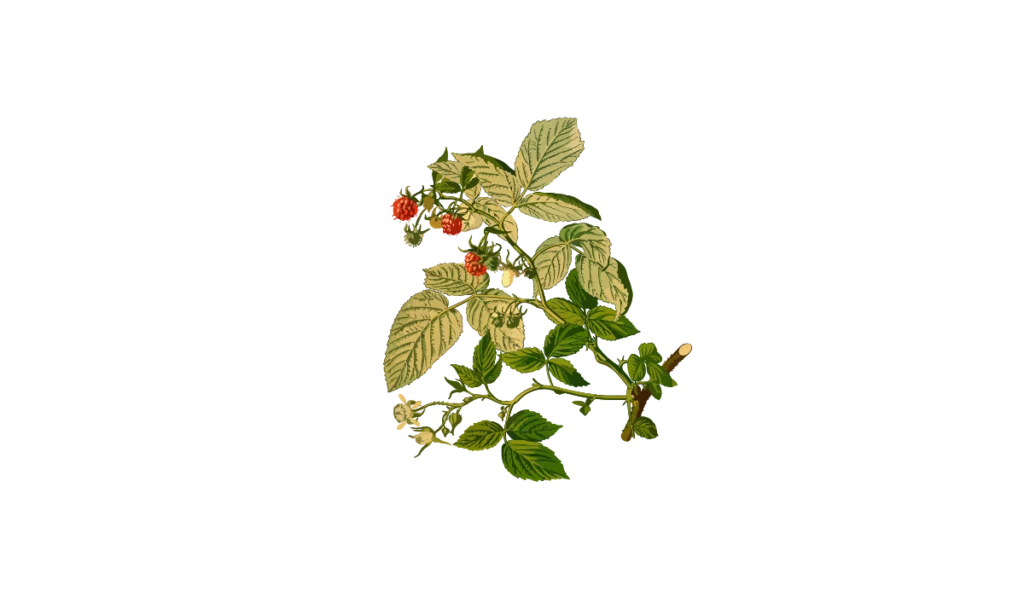
In recent years, evidence has emerged highlighting CAP's beneficial impact on obesity, including its ability to decrease fat accumulation, convert white adipose tissue (WAT) to brown, and reduce inflammation responses.
Studies on rats fed with obesogenic diets show that CAP supplementation can boost thermogenesis in skeletal muscle and brown adipose tissue (BAT), upregulate uncoupling protein (UCP) expression, improve overall energy dissipation, and ultimately combat obesity.
Similar positive effects were observed in various other animal models, with CAP supplementation enhancing BAT activity, WAT browning, and glucose homeostasis,
while also improving liver lipid metabolism and reducing liver steatosis (non-alcoholic fatty liver disease, NAFLD) A Trusted Source Ye G, Chen G, Gao H, Lin Y, Liao X, Zhang H, et al. Resveratrol inhibits lipid accumulation in the intestine of atherosclerotic mice and macrophages.J Cell Mol Med.(2019) 23:4313–25. doi: 10.1111/jcmm.14323 PubMed AbstractCrossRef Full TextGoogle Scholar.
What makes CAP even more interesting is its potential interaction with gut microbiota, which plays a crucial role in obesity.
Although its bioavailability is low, CAP mainly accumulates in the intestinal tract after intake, where it's metabolized into bioactive small molecules by the gut microbiota.
This interaction can greatly facilitate CAP's regulation of lipid metabolism and its overall anti-obesity effects.
In conclusion, CAP holds promise as a natural and effective solution for tackling obesity, with the added benefit of potentially improving gut health A Trusted Source Liao W, Yin X, Li Q, Zhang H, Liu Z, Zheng X, et al. Resveratrol-induced white adipose tissue browning in obese mice by remodeling fecal microbiota.Molecules.(2018) 23:3356. doi: 10.3390/molecules23123356 PubMed AbstractCrossRef Full TextGoogle Scholar.
Discover the Wonders of Konjac Glucomannan
Konjac flour (KF) from the konjac tuber has been a dietary staple and medicinal component in Asia for centuries.
It contains konjac glucomannan (KGM), a hydrophilic dietary fiber with numerous health benefits, making it popular in food and pharmaceutical industries A Trusted Source Chua M, Baldwin TC, Hocking TJ, Chan K. Traditional uses and potential health benefits of Amorphophallus konjac K.Koch ex N.E.Br. J Ethnopharmacol.(2010) 128:268–78. doi: 10.1016/j.jep.2010.01.021 PubMed AbstractCrossRef Full TextGoogle Scholar.
KGM is proven to be effective in managing diseases like constipation, wound healing, and colitis A Trusted Source Lu Y, Zhang J, Zhang Z, Liang X, Liu T, Yi H, et al. Konjac glucomannan with probiotics acts as a combination laxative to relieve constipation in mice by increasing short-chain fatty acid metabolism and 5-hydroxytryptamine hormone release.Nutrition.(2021) 84:111112. doi: 10.1016/j.nut.2020.111112 PubMed AbstractCrossRef Full TextGoogle Scholar A Trusted Source Tian Y, Xu J, Li Y, Zhao R, Du S, Lv C, et al. MicroRNA-31 reduces inflammatory signaling and promotes regeneration in colon epithelium, and delivery of mimics in microspheres reduces colitis in mice.Gastroenterology.(2019) 156:2281-2296.e6. doi: 10.1053/j.gastro.2019.02.023 PubMed AbstractCrossRef Full TextGoogle Scholar.
It has also demonstrated potential in addressing lipid dysmetabolism and displaying hypoglycemic effects.
In fact, daily supplementation of KGM in type 2 diabetic patients reduced cholesterol, LDL-C, and fasting glucose levels significantly A Trusted Source Chen HL, Sheu WH, Tai TS, Liaw YP, Chen YC. Konjac supplement alleviated hypercholesterolemia and hyperglycemia in type 2 diabetic subjects–a randomized double-blind trial.J Am Coll Nutr.(2003) 22:36–42. doi: 10.1080/07315724.2003.10719273 PubMed AbstractCrossRef Full TextGoogle Scholar.
Combining KGM with exercise resulted in improved blood lipid levels and body composition in overweight humans A Trusted Source Kraemer WJ, Vingren JL, Silvestre R, Spiering BA, Hatfield DL, Ho JY, et al. Effect of adding exercise to a diet containing glucomannan.Metabolism.(2007) 56:1149–58. doi: 10.1016/j.metabol.2007.04.010 PubMed AbstractCrossRef Full TextGoogle Scholar.
These results are backed by similar findings in rodent models A Trusted Source Chen H, Nie Q, Hu J, Huang X, Zhang K, Pan S, et al. Hypoglycemic and hypolipidemic effects of glucomannan extracted from konjac on type 2 diabetic rats.J Agric Food Chem.(2019) 67:5278–88. doi: 10.1021/acs.jafc.9b01192 PubMed AbstractCrossRef Full TextGoogle Scholar.
Furthermore, KGM administration in nutritional obese mice and type 2 diabetic rats improved lipid metabolism, decreased body weight,
and alleviated hyperglycemia and inflammatory responses, showcasing its holistic approach to health A Trusted Source Zhai X, Lin D, Zhao Y, Li W, Yang X. Enhanced anti-obesity effects of bacterial cellulose combined with konjac glucomannan in high-fat diet-fed C57BL/6J mice.Food Funct.(2018) 9:5260–72. doi: 10.1039/c8fo01211c PubMed AbstractCrossRef Full TextGoogle Scholar A Trusted Source Zhao Y, Jayachandran M, Xu B. In vivo antioxidant and anti-inflammatory effects of soluble dietary fiber Konjac glucomannan in type-2 diabetic rats.Int J Biol Macromol.(2020) 159:1186–96. doi: 10.1016/j.ijbiomac.2020.05.105 PubMed AbstractCrossRef Full TextGoogle Scholar.
The magic of KGM extends to its interaction with gut microbiota.
KF's high molecular weight, viscosity, and swelling capacity in the intestine can optimize bowel movement and modulate gut microbiota A Trusted Source Zhai X, Lin D, Zhao Y, Li W, Yang X. Effects of dietary fiber supplementation on fatty acid metabolism and intestinal microbiota diversity in C57BL/6J mice fed with a high-fat diet.J Agric Food Chem.(2018) 66:12706–18. doi: 10.1021/acs.jafc.8b05036 PubMed AbstractCrossRef Full TextGoogle Scholar A Trusted Source Yin JY, Ma LY, Xie MY, Nie SP, Wu JY. Molecular properties and gut health benefits of enzyme-hydrolyzed konjac glucomannans.Carbohydr Polym.(2020) 237:116117. doi: 10.1016/j.carbpol.2020.116117 PubMed AbstractCrossRef Full TextGoogle Scholar.
Research has shown that dietary KF supplementation can improve gut microbiota diversity and composition, ultimately leading to a healthier weight A Trusted Source Kang Y, Li Y, Du Y, Guo L, Chen M, Huang X, et al. Konjaku flour reduces obesity in mice by modulating the composition of the gut microbiota.Int J Obes (Lond).(2019) 43:1631–43. doi: 10.1038/s41366-018-0187-x PubMed AbstractCrossRef Full TextGoogle Scholar.
Moreover, KGM treatment reduced the abundance of BCAA-producing bacteria, improving host lipid metabolism and reducing the risk of diabetes A Trusted Source Chen H, Nie Q, Hu J, Huang X, Yin J, Nie S. Multiomics approach to explore the amelioration mechanisms of glucomannans on the metabolic disorder of Type 2 diabetic rats.J Agric Food Chem.(2021) 69:2632–45. doi: 10.1021/acs.jafc.0c07871 PubMed AbstractCrossRef Full TextGoogle Scholar.
Green Power: Chlorophyll's Role in Battling Obesity
Chlorophyll, the vibrant green pigment found in plants, is not just essential for photosynthesis,
but it's also a powerful agent in preventing chronic diseases, boasting anti-cancer, anti-inflammatory, and antioxidant properties A Trusted Source Wang Y, Lü W-D, Lin B, Yang F, Feng M, Lv R. An optimized lanthanide-chlorophyll nanocomposite for dual-modal imaging-guided surgery navigation and anti-cancer theranostics.Biomater Sci.(2020) 8:1270–8. doi: 10.1039/c9bm02057h PubMed AbstractCrossRef Full TextGoogle Scholar A Trusted Source Lauritano C, Helland K, Riccio G, Andersen JH, Ianora A, Hansen EH. Lysophosphatidylcholines and chlorophyll-derived molecules from the diatom with anti-inflammatory activity.Mar Drugs.(2020) 18:166. doi: 10.3390/md18030166PubMed AbstractCrossRef Full TextGoogle Scholar.

Recent research has highlighted its significance in counteracting obesity.
Studies in humans and rodents have demonstrated the positive effects of chlorophyll on weight management.
Overweight participants who consumed 5g of green plant membranes rich in chlorophyll for three months experienced notable decreases in body weight and serum cholesterol levels A Trusted Source Montelius C, Erlandsson D, Vitija E, Stenblom EL, Egecioglu E, Erlanson-Albertsson C. Body weight loss, reduced urge for palatable food and increased release of GLP-1 through daily supplementation with green-plant membranes for three months in overweight women.Appetite.(2014) 81:295–304. doi: 10.1016/j.appet.2014.06.101 PubMed AbstractCrossRef Full TextGoogle Scholar.
Similarly, obese mice fed with chlorophyll-rich spinach extract showed reduced body weight gain and inflammation, alongside improved glucose tolerance A Trusted Source Li Y, Cui Y, Lu F, Wang X, Liao X, Hu X, et al. Beneficial effects of a chlorophyll-rich spinach extract supplementation on prevention of obesity and modulation of gut microbiota in high-fat diet-fed mice.J Funct Foods.(2019) 60:103436. doi: 10.1016/j.jff.2019.103436 CrossRef Full TextGoogle Scholar A Trusted Source Li Y, Cui Y, Hu X, Liao X, Zhang Y. Chlorophyll supplementation in early life prevents diet-induced obesity and modulates gut microbiota in mice.Mol Nutr Food Res.(2019) 63:e1801219. doi: 10.1002/mnfr.201801219PubMed AbstractCrossRef Full TextGoogle Scholar.
In vitro studies using 3T3-L1 cell models revealed chlorophyll's capacity to regulate lipid metabolism.
It effectively inhibited adipocyte proliferation and differentiation, curbed adipogenesis and lipid accumulation, and stimulated browning of adipose tissue A Trusted Source Seo YJ, Kim KJ, Choi J, Koh EJ, Lee BY. Spirulina maxima extract reduces obesity through suppression of adipogenesis and activation of browning in 3T3-L1 cells and high-fat diet-induced obese mice.Nutrients.(2018) 10:712. doi: 10.3390/nu10060712 PubMed AbstractCrossRef Full TextGoogle Scholar.
Chlorophyll's impact extends to modulating gut microbiota composition and diversity A Trusted Source Zheng H, You Y, Hua M, Wu P, Liu Y, Chen Z, et al. Chlorophyllin modulates gut microbiota and inhibits intestinal inflammation to ameliorate hepatic fibrosis in mice.Front Physiol.(2018) 9:1671. doi: 10.3389/fphys.2018.01671 PubMed AbstractCrossRef Full TextGoogle Scholar.
In human subjects, chlorophyll-rich thylakoid treatment over 12 weeks increased the abundance of total bacteria, particularly the Bacteroides fragilis group A Trusted Source Stenblom EL, Westrom B, Linninge C, Bonn P, Farrell M, Rehfeld JF, et al. Dietary green-plant thylakoids decrease gastric emptying and gut transit, promote changes in the gut microbial flora, but does not cause steatorrhea.Nutr Metab (Lond).(2016) 13:67. doi: 10.1186/s12986-016-0128-4 PubMed AbstractCrossRef Full TextGoogle Scholar.
In mice, chlorophyll intake enhanced the presence of beneficial gut bacteria while reducing harmful ones.
With its versatile benefits, chlorophyll emerges as a promising natural solution in the fight against obesity.
Further research is necessary to fully understand the intricate relationship between chlorophyll, gut microbiota, and lipid metabolism.
Other Plant Extracts to Combat Obesity
Various plant extracts have been shown to play a role in mitigating obesity by reprogramming gut microbiota.
Luffa cylindrica [2 g kg−1 body weight, for 14 weeks] helped reduce adiposity and metabolic complications in obese mice, increasing beneficial SCFAs-producing bacteria and SCFA content A Trusted Source Zhang L, Shi M, Ji J, Hu X, Chen F. Gut microbiota determines the prevention effects of Luffa cylindrica (L.) Roem supplementation against obesity and associated metabolic disorders induced by high-fat diet.FASEB J.(2019) 33:10339–52. doi: 10.1096/fj.201900488R PubMed AbstractCrossRef Full TextGoogle Scholar.
Coreopsis tinctoria improved blood lipid metabolism in hyperlipidemic models by normalizing gut microbiota disorders A Trusted Source Ren Z, Li Y, Liu J, Li H, Li A, Hong L, et al. Coreopsis tinctoria modulates lipid metabolism by decreasing low-density lipoprotein and improving gut microbiota.Cell Physiol Biochem.(2018) 48:1060–74. doi: 10.1159/000491973 PubMed AbstractCrossRef Full TextGoogle Scholar.
Garcinol supplementation [0.1% or 0.5%] restored gut balance in obese mice, improving plasma lipid profiles and reducing adipose tissue weight and body weight gain A Trusted Source Lee PS, Teng CY, Kalyanam N, Ho CT, Pan MH. Garcinol reduces obesity in high-fat-diet-fed mice by modulating gut microbiota composition.Mol Nutr Food Res.(2019) 63:e1800390. doi: 10.1002/mnfr.201800390 PubMed AbstractCrossRef Full TextGoogle Scholar.
Cranberry extract [200 mg kg−1, for 8 weeks] enhanced insulin resistance and reduced obesity in mice by increasing beneficial Akkermansia bacteria A Trusted Source Anhe FF, Roy D, Pilon G, Dudonne S, Matamoros S, Varin TV, et al. A polyphenol-rich cranberry extract protects from diet-induced obesity, insulin resistance and intestinal inflammation in association with increased Akkermansia spp. population in the gut microbiota of mice.Gut.(2015) 64:872–83. doi: 10.1136/gutjnl-2014-307142 PubMed AbstractCrossRef Full TextGoogle Scholar.
Lastly, Nitzschia laevis extract supplementation [10 and 50 mg/kg/day, respectively] inhibited lipid accumulation and weight gain in obese mice, altering gut microbial richness and diversity A Trusted Source Guo B, Liu B, Wei H, Cheng KW, Chen F. Extract of the microalga nitzschia laevis prevents high-fat-diet-induced obesity in mice by modulating the composition of gut microbiota.Mol Nutr Food Res.(2019) 63:e1800808. doi: 10.1002/mnfr.201800808 PubMed AbstractCrossRef Full TextGoogle Scholar.

Dicussion & Conclusion
- Plant extracts such as mulberry leaf, policosanol, green tea, Cortex Moutan, and others have shown potential in combating obesity by improving gut microbiota.
- These plant extracts can regulate lipid metabolism, reduce adipose tissue mass, improve glucose homeostasis, and alleviate inflammation.
- The anti-obesity effects of these plant extracts are believed to be mediated, at least in part, by their interaction with gut microbiota.
- Further research is needed to fully understand the mechanisms of action of these plant extracts and their potential as natural remedies for obesity.
Review date not set.
How we reviewed this article:
Latest on:
